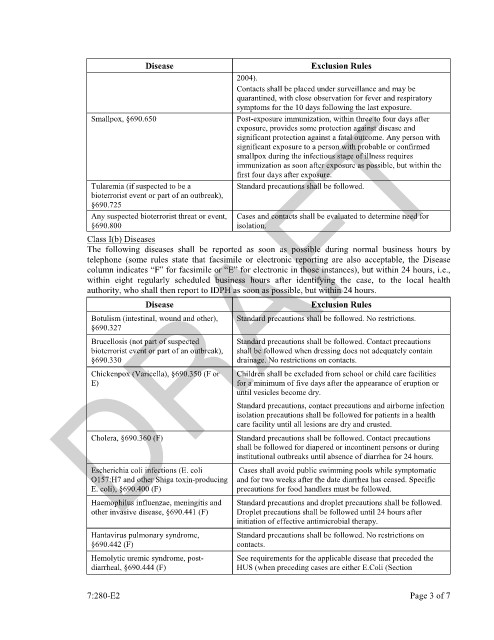Page 1196 - Draft
P. 1196
Disease Exclusion Rules
2004).
Contacts shall be placed under surveillance and may be
quarantined, with close observation for fever and respiratory
DRAFT
symptoms for the 10 days following the last exposure.
Smallpox, §690.650 Post-exposure immunization, within three to four days after
exposure, provides some protection against disease and
significant protection against a fatal outcome. Any person with
significant exposure to a person with probable or confirmed
smallpox during the infectious stage of illness requires
immunization as soon after exposure as possible, but within the
first four days after exposure.
Tularemia (if suspected to be a Standard precautions shall be followed.
bioterrorist event or part of an outbreak),
§690.725
Any suspected bioterrorist threat or event, Cases and contacts shall be evaluated to determine need for
§690.800 isolation.
Class I(b) Diseases
The following diseases shall be reported as soon as possible during normal business hours by
telephone (some rules state that facsimile or electronic reporting are also acceptable, the Disease
column indicates “F” for facsimile or “E” for electronic in those instances), but within 24 hours, i.e.,
within eight regularly scheduled business hours after identifying the case, to the local health
authority, who shall then report to IDPH as soon as possible, but within 24 hours.
Disease Exclusion Rules
Botulism (intestinal, wound and other), Standard precautions shall be followed. No restrictions.
§690.327
Brucellosis (not part of suspected Standard precautions shall be followed. Contact precautions
bioterrorist event or part of an outbreak), shall be followed when dressing does not adequately contain
§690.330 drainage. No restrictions on contacts.
Chickenpox (Varicella), §690.350 (F or Children shall be excluded from school or child care facilities
E) for a minimum of five days after the appearance of eruption or
until vesicles become dry.
Standard precautions, contact precautions and airborne infection
isolation precautions shall be followed for patients in a health
care facility until all lesions are dry and crusted.
Cholera, §690.360 (F) Standard precautions shall be followed. Contact precautions
shall be followed for diapered or incontinent persons or during
institutional outbreaks until absence of diarrhea for 24 hours.
Escherichia coli infections (E. coli Cases shall avoid public swimming pools while symptomatic
O157:H7 and other Shiga toxin-producing and for two weeks after the date diarrhea has ceased. Specific
E. coli), §690.400 (F) precautions for food handlers must be followed.
Haemophilus influenzae, meningitis and Standard precautions and droplet precautions shall be followed.
other invasive disease, §690.441 (F) Droplet precautions shall be followed until 24 hours after
initiation of effective antimicrobial therapy.
Hantavirus pulmonary syndrome, Standard precautions shall be followed. No restrictions on
§690.442 (F) contacts.
Hemolytic uremic syndrome, post- See requirements for the applicable disease that preceded the
diarrheal, §690.444 (F) HUS (when preceding cases are either E.Coli (Section
7:280-E2 Page 3 of 7

